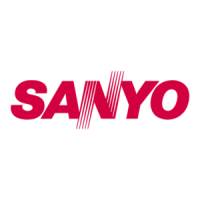2
2-3
2-4. Items to Check Before the Test Run
(1) Turn the remote power switch ON at least 12
hours in advance in order to energize the crank
case heater.
(2) Fully open the closed valves on the liquid-tube and
gas-tube sides.
2-5. Test Run Using the Remote Controller
(1) Press and hold the remote controller button
for 4 seconds or longer. Then press the
button.
“TEST” appears in the LCD display during the
test run.
Temperature control is not possible when test
run mode is engaged.
(This mode places a large load on the devices.
Use it only when performing the test run.)
(2) Use either Heating or Cooling mode to perform the
test run.
The outdoor unit will not operate for approximately
3 minutes after the power is turned ON or after it
stops operating.
(3) If normal operation is not possible, a code appears
on the remote controller LCD display.
Refer to “2-7. Table of Self-Diagnostic Functions and
Corrections”, and correct the problem.
(4) After the test run is completed, press the button
again. Check that “TEST” disappears from the LCD
display.
(This remote controller includes a function that
cancels test run mode after a 60-minute timer has
elapsed, in order to prevent continuous test run
operation.)
(5) For the test run of an inverter outdoor unit, operate
the compressors for a minimum of 10 minutes (in
order to check for open phase).
* When performing a test run using a wired remote
controller, operation is possible without attaching
the cassettetype ceiling panel.
( “P09” will not be displayed.)
2-6. Precautions
Request that the customer be present when the test
run is performed. At this time, explain the operation
manual and have the customer perform the actual
steps.
Be sure to pass the manuals and warranty certificate
to the customer.
Check that the 220 – 240 V AC power is not connec-
ted to the inter-unit control wiring connector terminal.
* If 220 – 240 V AC is accidentally applied, the indoor
or outdoor unit control PCB fuse will blow in order to
protect the PCB. Correct the wiring connections, then
disconnect the 2P connectors that are connected to
the PCB, and replace them with 2P connectors.
If operation is still not possible after changing the
brown connectors, try cutting the varistor.
(Be sure to turn the power OFF before performing
this work.)
XM Type
Fuse 5A
CHK (2P plug)
2P connector (brown)
2P connector (blue)
JP003
Power PCB
Control PCB
Outdoor unit control PCB
8 – 10 HP
LED1
FUSE (0.5A, F500)
OC (CN500, BLU)
MOV2
(CN301, BLK)
MOV1
(CN300, WHT)
EMG (CN502, BRN)
SILENT (CN037, WHT)
PUMP DOWN (CN048)
TEMINAL (CN205, BLK)
R.C.ADD. Rotary switch
C2 (CN020, WHT)
C1 (CN021, WHT)
TEST (CN033, RED)
TD (CN024, BLK)
TO (CN023, BLK)
TS (CN022, RED)
63PH (CN027, WHT)
EXCT
(CN030, RED)
RC P
(CN039, RED)
IC002
CTL2
(CN202, GRN)
CTL1
(CN203, GRN)
FUSE
(6.3A, F101)
N.P.CHECK
(CN046, RED)
LED2
MODE (CN038)
D115
IC001
R.C.ADD. DIP switch
A.ADD (CN047)
C-CHK (CN035)
EEPROM
LED (D041)
Fig. 2-4
CHK (2P plug)
2P connector (brown)
2P connector (blue)
Varistor (black)
VA100
Fuse 0.5A
Indoor unit control PCB
NOTE
SM830161Book.indb3SM830161Book.indb3 2008/06/039:09:022008/06/039:09:02

